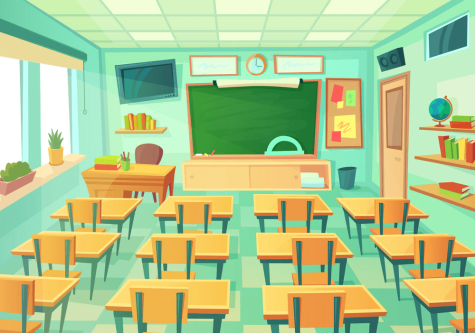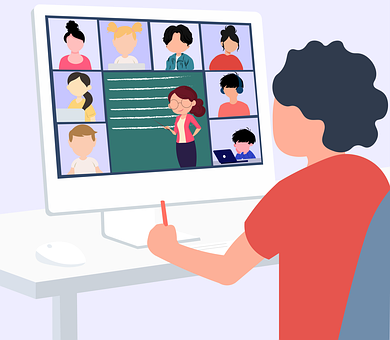Pushing the “Reset Button”: Why a Period of Online Learning Will be Beneficial For Many.
Numbers are higher than ever. Teachers are as worn out as ever. Parents are worried and students are faced with COVID everyday. Should schools realistically be engaging in in-person learning right now?
January 17, 2022
Since March of 2020, it seems like education has rarely been consistent.
First the “rookie year” of online learning in March 2020, then in-person learning a few months later, soon came the confusing and awkward strategy of hybrid learning . . . a few months later after the holidays meant back online. It seemed like everyone was together in the classroom again towards the end of the 2020-2021 school year, but then 2021-2022 took an unexpected turn with the rise of the new Omicron variant. If education ever wants to return to a traditional classroom setting like myself and many other students and educators want it to, then engaging in online learning for a period of time is not only necessary, but needed more than ever right now.

The most immense issue schools are facing now are problems relating to staffing shortages. The most recent Omicron variant is a highly contagious strain of COVID-19. That is proven by the scarce amount of teachers physically at school and the amount of subs needed to cover classes. Not only are staffing shortages inconvenient, they make it extremely difficult for a school to function properly.
Quarantines among teachers are far from favorable for students in a classroom. Practicing online learning for a period of time very well may decrease the high spike in numbers of the variant and work to keep everyone together in school; something many across the globe desire. In a recent article written by Vox, “When a teacher is sick or in quarantine, someone has to cover their classes. The same is true for bus drivers, cafeteria workers, and other adults in school buildings- someone has to do the work, or the school can’t function” (Vox). Teachers are not the only educacional personnel in the school buildings that are short on staff, it is all of those working in the building. No staff means no functioning school, and a period of online learning can bring those missing staff back into the classroom.
UFT President Michael Mulgrew also can see the problem with staffing shortages at schools, especially after holiday breaks and the overwhelming number of positive cases.
“‘That’s why we advised the mayor today that we should go remote for at least a couple of days, because we need to really figure out where we’re at in staffing capacity”’ (CBS New York). Not only is staffing capacity an issue, it is uncertain and changes every day; no educator will ever really know what each day will look like.

To read more about Anna North’s views about the stresses of schools during the pandemic check it out here: https://www.vox.com/the-goods/22868641/chicago-school-closings-omicron-covid-remote-learning
Life at home is also a major factor many should take into consideration when evaluating whether or not in person learning is safe at the moment. If a student has a health condition that increases the risk of catching COVID-19, remote learning is a safer option to reduce the possibility of exposure. Pre-existing conditions could increase the risk of severe illness from COVID like kidney and heart disease. Not only are students with conditions at risk, but family members at home could be also.
The “life at home” issue is not solely related to underlying health conditions, but how available families are to accommodate isolations and quarantines. Dr. Charlene Wong, assistant professor of pediatrics at Duke University and executive director of the North Carolina Integrated Care for kids program states that “A child who had classroom contact with another student who was diagnosed with the coronavirus would likely have to quarantine at home for 14 days. ‘Is that something that your family can accommodate?” (U.S. News). Some families may not have the availability or time to assist a quarantined or sick child, which is why online learning for a period of time can not only decrease the rise in positive cases, but provide some support with those who may not be able to care for isolated children.

Staffing shortages are most certainly a top struggle within education systems during the COVID-19 pandemic, especially during the time of the spike in the Omicron variant. However, the mental toll teachers and staff are taking on is not widely talked about. Between covering classes, risking their own health and life at home, and also doing many more jobs than they signed up for at once seems like something teachers are being silenced for.
Teachers are almost like a punching bag as they try to teach during the pandemic. Dennis Roche, president of Burbio stated that “‘The job of a typical teacher has been extended”’ (Vox), meaning that teachers are now expected to do not only many different jobs like mask enforcement, disinfecting classrooms, and contact tracing, they also have to do it all at once.
Sobia Sheikh, a high school math teacher in Washington state agrees that schools and teachers are in a crisis across the nation. Sheikh told Vox that “‘Everyday we’d get emails: Hey, we need someone to cover fourth period, sixth period, seventh period.’” (Vox). Another teacher confessed that “‘A lot of teachers feel like the world doesn’t like us anymore”’(Vox).Teachers seem to really be taking a beating during this pandemic and feel like no one acknowledges the immense amount of stress they are going through.
While it is true that online school limits the social and emotional learning that takes place, especially for younger students, this reason is not so compelling in an argument when one considers the idea of “learning pods; a way for students to stay connected socially and emotionally while online learning” (U.S. News). Parents are taking it upon themselves to form these learning pods where multiple students get together for school. In this situation, one or more parents could check in on the students – depending on their age – as they learn virtually. (U.S. News). ‘Pods could be one solution to allow an opportunity for social and emotional learning among a smaller group of children,’ as long as there is a lower risk of exposure, Wong says.
“Being with friends is extremely important to school-aged students,” says Sievering, a member of the National Assosiation of School Psychologists. “If communities don’t offer safe options for children to be together, they’ll hang out any way they can. We need to be creative and find ways for children to be together safely’” (U.S. News). This is a great interim idea for the time that could be for online learning for a period of time to not have to communicate or work visually, but in a physical classroom.
The pandemic has been extremely hard on countless amounts of people around the world. The recent spike of the new COVID variant is no expectation. Engaging in a period of online learning can decrease these risks and issues countless schools are facing and help return students and staff especially back to normalcy in the classroom.
If you want to read more about COVID changes at Darien High School, check out here:
